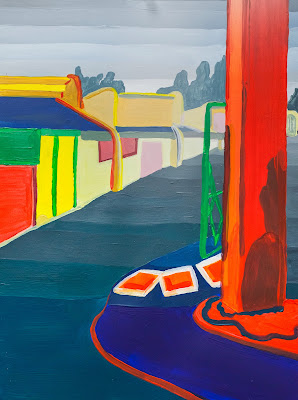Project Description
After having explored more systematic methods of muting color, you are now ready to work in a way that is more observational and interpretive as you explore nature's way of altering color. You will create a painting of a cityscape/landscape that gives the illusion of depth, using the concepts of both linear and atmospheric perspective. Your composition will be drawn from life. You may shoot photos to help create your composition and as reference to determine value (light/shadow), perspective, using elements on different planes as focal areas in immediate foreground, mid-ground, background.
Don't rely on photos alone. be interpretive with your environment. you should move things around if necessary to achieve an ideal composition. you should also select a color pallette for your painting and also think of enhancing the hues to create a harmonious color scheme. the hues will usually shift from more saturated to muted and ultimately hues of chromatic grays leaning towards lighter and cooler blue grays as you reach the horizon lines.
Don't rely on photos alone. be interpretive with your environment. you should move things around if necessary to achieve an ideal composition. you should also select a color pallette for your painting and also think of enhancing the hues to create a harmonious color scheme. the hues will usually shift from more saturated to muted and ultimately hues of chromatic grays leaning towards lighter and cooler blue grays as you reach the horizon lines.
The goal of this project is to apply what you have learned throughout this semester regarding color theory, the basic design components, composition, and painting technique to create a convincing landscape that shows illusion of depth.
Studio Day 1- In school. Create 4-5 sketches from life, sketch different points of views creating environments with large depth-of-field, creating an illusion of depth as far as you can see... consider immediate foreground, middle ground, and background.These will be graded.
for homework
Choose the best composition and redraw it on 9x12 bristol board. Be sure to address the following compositional concerns:
- What will my main focal point(s) be? How can I use line, shape and color to direct the viewer there?
- How is my eye moving around the page? Is the composition 'broken'- meaning, does your eye get stuck anywhere? If so, how can I fix the composition?
- Do the lines, shapes, and colors work together to create a sense of depth?
you may edit your images to improve your compositions moving elements around that makes sense in your drawing. This is ALSO interpretive. use the space wisely and not necessary to include so much detail. must give overall illusion of depth with different focal areas in each planes to help eye move around page.
Work on color schemes in your sketchbook. You must reference the color wheel when deciding on your colors. Have notes written in your sketchbook to answer the following questions:
- Which paints did you use to mix your colors?
- What color schemes will you use, and where?(analogous in background, triad in middle ground, split compliment in foreground, etc)
- How will you reduce the intensity/saturation and shift the value (lighter) and hue (cooler) as you move from foreground, through middle ground, to background?
- How will you create more contrast in the foreground, and less in the background? consider shadows, highlights, midtowns. contrast is important.
Studio Day 2- Painting
You will have 2 hours to paint your composition. Be sure to have your sketchbook notes and composition with you.
1:10pm- set up paints, etc. while I review the assignment.
1:30pm- painting session
3:30pm- clean up
3:45pm- dismissal
Rubric
You will be assessed on both your process (time-management, being prepared, following all steps), and your finished project. Project will be graded according to: composition, your ability to create a sense of depth, craftsmanship/technique, and creativity.
Rubric
You will be assessed on both your process (time-management, being prepared, following all steps), and your finished project. Project will be graded according to: composition, your ability to create a sense of depth, craftsmanship/technique, and creativity.
What is Atmospheric Perspective?
http://www.arthints.com/what-is-atmospheric-perspective/
These are original scans of student work. they are digitally altered images and adjustments were made to show the improvements in creating atmospheric perspective. Improvements were made by increasing changes in contrast, saturation, and value as you move from foreground to background. ie. most contrast, and saturation in the foreground. least contrast and saturation in the background. Value was also increased (made lighter) in the background. As you look further away... elements become faded out.










